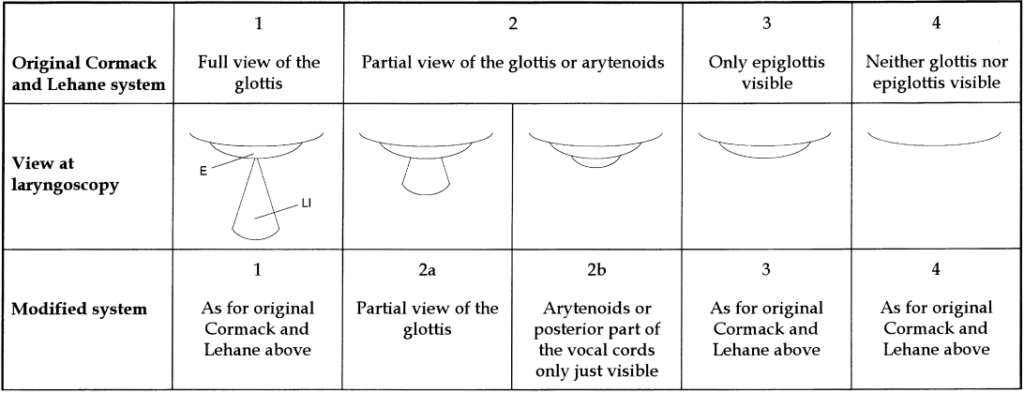Ronald Cormack
Ronald ‘Ronnie’ Sidney Cormack (1930 – ) English anaesthetist
Born in Rungoon Burma into a medical family, his Father was a surgeon (who received a military cross during the first world war) and his Mother was a ward sister in Charing cross. He graduated from Oxford University in 1961. He was a senior lecturer in Anaesthesia at Bristol university until his appointment to Northwick Park hospital where he met John Lehane.
Co-authored a paper with John Lehane in 1984 which formed the foundation of the Cormack-Lehane laryngoscopy grades. The paper has a citation score of >1600 making it one of the most quoted papers in science. Cormack and Lehane also advocated for practicing difficult intubation drills and techniques for when an unexpected difficult airway may arise.
Biography
- Born in 1930 in Rangoon, Burma where his surgeon father was head of military services
- 1961 – BM BCh, Graduated medicine from Oxford university
- Senior lecturer at Bristol
- 1972 – MRC unit at Northwick Park Hospital, Harrow in charge of the obstetric service. He worked with John Lehane from 1978 and together they worked on a system of teaching students intubation in Obstetric patients. This resulted in their famous classification of the laryngeal view into the four grades.
- 1984 – Co-author of the Cormack-Lehane scoring system, a simple classification system for grading direct laryngoscopy in Anaesthesia
- Early retirement to focus on his research interests and writing
- 2013 – Macewen Medal from the Difficult Airway Society
Medical Eponyms
Cormack-Lehane scoring system (1984)
Cormack and Lehane looked into previous research of maternal deaths in England and Wales; specifically looking into pulmonary aspiration. They found that difficult intubation was well known for certain diseases (e.g. ankylosing spondylitis) but it was not well documented why difficulty may arise in healthy patients.
They came up with the Cormack-Lehane grading system, a simple score for view obtained with direct laryngoscopy. This made it easy for beginners to describe what was likely to be an easy intubation (grade 1 and 2) or a difficult intubation (grade 3 and 4).
Difficult intubation has been classified into four grades, according to the view obtainable at laryngoscopy. Frequency analysis suggests that, in obstetrics, the main cause of trouble is grade 3, in which the epiglottis can be seen, but not the cords
Cormack and Lehane 1984
Classification describes the best glottic view possible at laryngoscopy:
- Grade I: complete glottis visible
- Grade II: anterior glottis not seen; and only the posterior extremity of the glottis is visible
- Grade III: epiglottis seen, but not glottis
- Grade IV: epiglottis not seen

1998 – A modified version of grade II was developed by Yentis and Lee, subdividing II into 2a and 2b. Where 2a is partial view of the glottis and 2b is only the posterior aspect of the glottis or only the arytenoid cartilage.

Major Publications
- Cormack RS, Lehane J. Difficult tracheal intubation in obstetrics. Anaesthesia. 1984; 39(11): 1105-1111.
- Cormack RS. Cormack-Lehane classification revisited. Br J Anaesth. 2010; 105(6): 867-868.
References
Biography
- Ronnie Cormack. DAS Medal, 2012
- Maltby JR. Cormack-Lehane laryngoscopy grades. In: Notable Names in Anaesthesia. The Choir Press, 2013: 43-45
- Ronald Cormack. Research Gate
Eponymous terms
- Samsoon GLT, Young JRB. Difficult tracheal intubation: a retrospective study, Anaesthesia 1987; 42: 487
- Wilson ME et al. Predicting difficult intubation. Br J Anaesth. 1988; 61(2): 211-216.
- Bond A. Obesity and difficult intubation. Anaesth Intensive Care. 1993; 21(6): 828-830. Laryngoscopy technique. Anaesthesia UK
- Yentis SM, Lee DJ. Evaluation of an improved scoring system for the grading of direct laryngoscopy. Anaesthesia. 1998 Nov;53(11):1041-4
- Krage R, van Rijn C, van Groeningen D, Loer SA, Schwarte LA, Schober P. Cormack-Lehane classification revisited. Br J Anaesth. 2010; 105(2): 220-227
- Pearce AC, Duggan LV, El-Boghdadly K. Making the grade: has Cormack and Lehane grading stood the test of time? Anaesthesia. 2021; 76(5): 705-709
[cite]
Doctor currently working in South Wales, training in anaesthetics. Graduated Leeds University with MB ChB with BSc in microbiology in relation to medicine. Special interests in emergency medicine, critical care and anaesthetics

